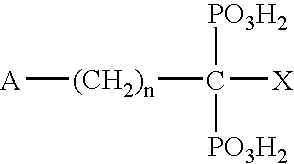Cathespin cysteine protease inhibitors
a protease inhibitor and cathespin cysteine technology, applied in the field of cathespin cysteine protease inhibitors, can solve the problems of low bone density of a large segment of the older population, weaker bone structure, and high risk of fractures, and achieve the effect of treating and/or preventing cathepsin-dependent conditions
- Summary
- Abstract
- Description
- Claims
- Application Information
AI Technical Summary
Benefits of technology
Problems solved by technology
Method used
Image
Examples
example 1
Synthesis of N1(cyanomethyl)-N2{(1S)-2,2,2-trifluoro-1-[4′-(methysulfonyl)-1,1′-biphenyl-4-yl]ethyl}-L-leucinamide
[0217][0218]Step 1: (2S)-1-{[tert-butyl(dimethyl)silyl]oxy}-4-methylpentan-2-amine
[0219]To a room temperature dichloromethane (100 mL) solution of L-leucinol (6.0 g) was added triethylamine (11 mL), DMAP (0.1 g) and t-butyldimethylsilyl chloride (8.5 g). The mixture was stirred at room temperature for 2 hours and then water was added. The organic layer was separated and the aqueous further extracted with dichloromethane. The combined organic layers were washed with brine, dried with magnesium sulfate and the solvent was removed in vacuo to yield the title compound, a residue which was used as such in the next reaction.
[0220]1H NMR (CD3COCD3) δ 3.48(m, 2H), 3.32(m, 1H), 2.76(m, 1H), 1.78(m, 1H), 1.22-1.02(m, 2H), 0.88(m, 15H), 0.06(s, 6H).[0221]Step 2: (2S)-1-{[tert-butyl(dimethyl)silyl]oxyl}-4-methyl-N-[(1E)-2,2,2-trifluoroethylidene]pentan-2-amine
[0222]A toluene (300 mL...
example 2
Preparation of N1-(1-cyanocyclopropyl)-4-fluoro-N2-{(1S)-2,2,2-trifluoro-1-[4′-(methylsulfonyl)-1,1′-biphenyl-4-yl]ethyl}-L-leucinamide
[0240][0241]Step 1: Benzyl (3S)-3-[(tert-butoxycarbonyl)amino]-4-hydroxybutanoate
[0242]N-(tert-Butoxycarbonyl)-L-aspartic acid 4-benzyl ester (30 g) was dissolved in dimethoxyethane (90 mL) and the solution was cooled to −5° C. N-Methylmorpholine (10.32 mL) was added followed by isobutyl chloroformate (12.7 mL) in such a way to keep the temperature below −10° C. The mixture was aged for 0.5 hour. The solids were quickly filtered and washed with dimethoxyethane (90 mL). To the filtrate cooled to −50° C. was carefully added sodium borohydride (4.4 g) as a solution in water (45 mL) in such a way to keep the temperature between −30° C. and −15° C. After all the hydride had been added, water (500 mL) was added in such a way to maintain the temperature below −15° C. The suspension was filtered, the solid washed with water (400 mL) and dried to yield benzyl...
example 3
Preparation of 1-[4′-[(1S)-1-[[(1S)-1-[[(1-cyanocyclopropyl)amino]carbonyl]-3-fluoro-3-methylbutyl]amino]-2,2,2-trifluoroethyl][1,1′-biphenyl]-4-yl]-cyclopropanecarboxylic acid
[0277][0278]Step 1: 1-(4-bromophenyl)cyclopropanecarbonitrile
[0279]To a room temperature solution of 4-bromophenylacetonitrile (18.0 g) in 22 mL of sodium hydroxide (50% in water W / W) were added 1-bromo-2-chloroethane and (12.0 mL) and benzyltriethylammonium chloride (627 mg). The mixture was heated at 60° C. overnight. The reaction mixture was cooled to room temperature and diethyl ether was added (300 mL. The ether layer was washed with water (100 DL), hydrogen chloride (100 mL, 10% HCl in water) and brine. The organic layer was dried with magnesium sulfate and the solvent removed in vacuo. The residue was purified by trituration using diethyl ether and hexanes to yield the title compound.
[0280]1H NMR (CD3COCD3) δ 7.60(2H, d), 7.35(2H, d), 1.74-1.80(2H, m), 1.52-1.57(2H, m).[0281]Step 2: 1-(4-bromophenyl)cyc...
PUM
| Property | Measurement | Unit |
|---|---|---|
| active weight | aaaaa | aaaaa |
| pH | aaaaa | aaaaa |
| temperature | aaaaa | aaaaa |
Abstract
Description
Claims
Application Information
 Login to View More
Login to View More - R&D
- Intellectual Property
- Life Sciences
- Materials
- Tech Scout
- Unparalleled Data Quality
- Higher Quality Content
- 60% Fewer Hallucinations
Browse by: Latest US Patents, China's latest patents, Technical Efficacy Thesaurus, Application Domain, Technology Topic, Popular Technical Reports.
© 2025 PatSnap. All rights reserved.Legal|Privacy policy|Modern Slavery Act Transparency Statement|Sitemap|About US| Contact US: help@patsnap.com



